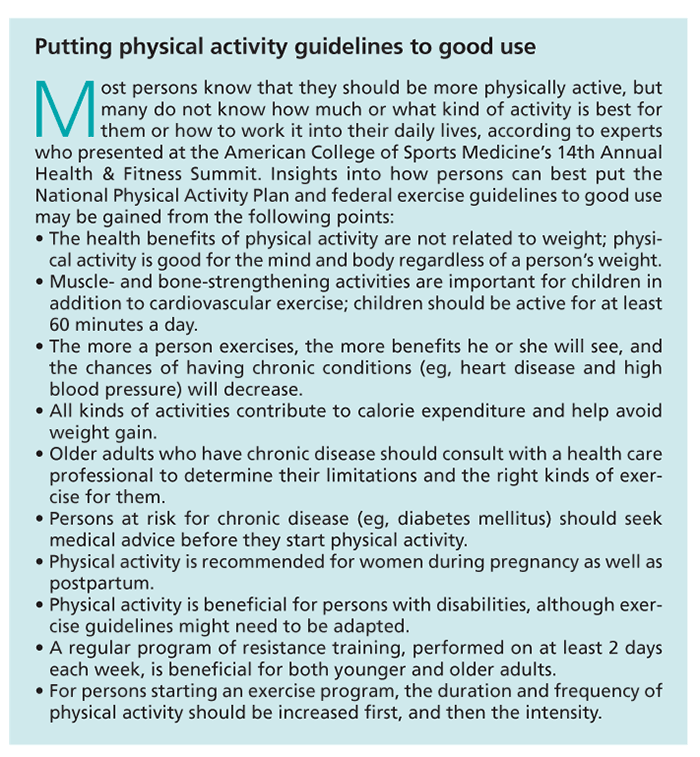Physical activity plan recommends new “vital sign”
Author(s):
Health care professionals should make physical activity a vital sign that they assess and discuss with their patients as part of the recently announced National Physical Activity Plan, according to the American College of Sports Medicine (ACSM)
Health care professionals should make physical activity a vital sign that they assess and discuss with their patients as part of the recently announced National Physical Activity Plan, according to the American College of Sports Medicine (ACSM). The initiative-the first national, comprehensive plan to support and encourage physical activity among all Americans-calls for policy, environmental, and cultural changes to help persons realize the health benefits of physical activity.
The National Physical Activity Plan is, in part, a response to high rates of adult and childhood obesity and decreasing levels of physical activity, according to the ACSM, which cited research showing that physical activity and exercise can help prevent and manage obesity, diabetes mellitus, coronary heart disease, depression, bone disease, and cancer. Implementation of the plan's measures could improve public health, cut health care costs, and reduce health disparities.
The plan's goal is that all Americans become physically active and live, work, and play in environments that facilitate regular physical activity. A wide range of public policy recommendations are offered across 8 broad sectors that have a direct effect on the physical activity levels and health of persons in the United States: (1) health care; (2) public health; (3) business and industry; (4) education; (5) mass media; (6) parks, recreation, fitness, and sports; (7) transportation, urban design, and community planning; and (8) volunteer and nonprofit organizations.

In addition to calling on health care professionals to make physical activity a vital sign, the plan recommends the following strategies for other specific sectors:
•In education, develop and implement policies that require school accountability for the quality and quantity of physical education and physical activity.
•In transportation and planning, use routine performance measures and set benchmarks for active travel (eg, walking, biking, public transit).
•In recreation, enhance existing parks and the recreation infrastructure with effective policy and environmental changes to promote physical activity.
•In business and industry, identify and disseminate best practice models for physical activity in the workplace.
The organizational infrastructure for the plan was provided by the CDC and the Prevention Research Center at the University of South Carolina. Key elements include the following:
•Providing a clear road map for increasing Americans' physical activity in the short and long terms.
•Developing strategies for increasing physical activity in all sectors of society and addressing disparities.
•Creating a social movement to sustain interest and involvement.
•Developing new strategies for promoting physical activity.
•Monitoring progress to assess achievements in increasing physical activity.
The National Physical Activity Plan is the product of a 10-month, public-private collaboration of experts in diverse fields and an ongoing collaboration of nonprofit organizations, corporations, and public agencies. Implementation will be led by the National Coalition for Promoting Physical Activity and helped by numerous partner organizations at the national, regional, and grassroots levels that collectively will promote public policy, track results, and launch a cause-related marketing campaign.
For more information about the activity plan, visit http://www.physicalactivityplan.org. Or, write to National Physical Activity Plan, 921 Assembly Street, Suite 212, Columbia, SC 29208; telephone (toll-free): (866) 365-5122; fax: (803) 777-2504.
The ACSM earlier developed its own guidelines, the 2008 Physical Activity Guidelines for Americans, which served as a basis for creating the federal guidelines (see the Box, “Putting physical activity guidelines to good use”). For more information, visit the ACSM Web site at http://www.acsm.org. Or, contact the organization at American College of Sports Medicine, PO Box 1440, Indianapolis, IN 46206-1440; telephone: (317) 637-9200; fax: (317) 634-7817.



